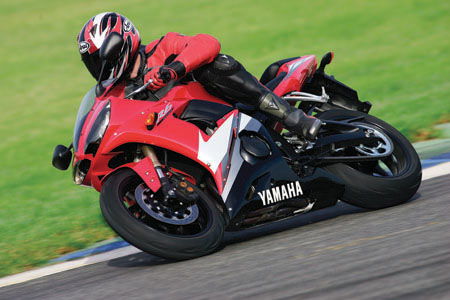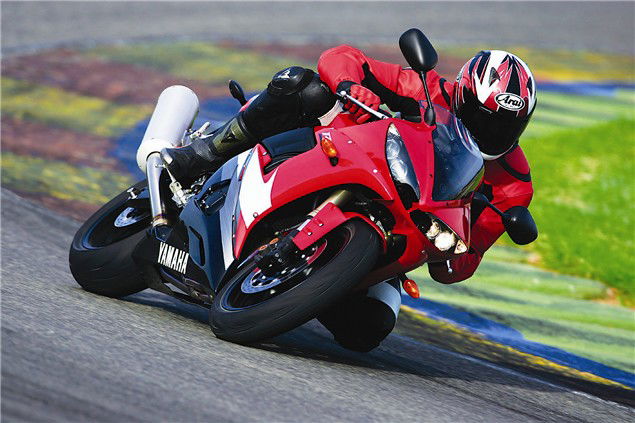First Ride: 2005 Yamaha YZF-R6
A number of performance-enhancing tweaks make this year's R6 a faster and more exciting proposition. Riding tips from Valentino Rossi not included...

 |
"Brake at the point where the kerb ends, keep the bike a little bit away from the edge of the track because it's slippery there, and turn into the corner when you get to about... here."
Valentino Rossi's words of advice are echoing through my mind as I squeeze the YZF-R6's front brake lever, brace myself against the fierce power of its new radial calipers, and just about manage to follow the curly-haired maestro's instructions as I aim the revamped middleweight through the right-hand hairpin of the Valencia circuit's infield.
Less than an hour ago I was walking round this turn while Rossi pointed out his line and reference points in his familiar sing-song English. Now I'm trying to put what he said into practice aboard the 2005 YZF-R6 which, while far from being a factory MotoGP missile like Valentino's M1, incorporates a number of modifications designed to make it faster and more exciting to ride.
The Yamaha flicks into the tight and tricky right turn with notable ease, and when I wind open the throttle, the bike tonks off up the next straight with what feels like a touch more of the high-rev acceleration for which the R6 has been known ever since its launch in 1999.
That more aggressive feeling is not just in my imagination, because it's what project leader Makoto Shimamoto has tried to engineer into the R6. Unsurprisingly, Yamaha's research shows that R6 buyers - of whom there have been more than 100,000 over the last six years - are seriously into racing and track days. So under the headline 'Pure Racing Performance' this update is aimed to increase both performance and the bike's feeling of speed.
The 599cc, 16-valve engine is mechanically unchanged. Outside it, larger diameter throttle bodies, redesigned intake trumpets, revised fuel-injection settings and new ignition timing increase peak power by 3bhp to a claimed 120bhp max at 13,000rpm, or 126bhp with ram-air effect included. Peak torque remains 49 lb.ft (51 lb.ft with ram-air) at 12,000rpm.
Chassis mods are centred on the front end, which gets 41mm upside-down forks based on the R1's 43mm units, plus radial four-pot calipers and master cylinder that are identical to big brother's. The brake discs are larger at 310mm (from 298mm) in diameter and are lighter because they're 0.5mm thinner. Rake and trail are increased slightly, and the R6 gets a 120/70 front tyre instead of the previous 120/60. The rear end is also tweaked with a stiffer shock spring, revised linkage ratio, and slightly thicker and more rigid frame section around the swing-arm pivot.
There's no denying that the visually near-unchanged R6, with its conventional four-into-one pipe, looks a bit dull alongside the likes of Kawasaki's ZX-6R. That's unless you include the limited-edition R46, styled by Valentino with his '46' logo plus sun and moon symbols on a yellow-and-black background. The newly recrowned champ made a flying visit to Valencia to show us some lines around the circuit and put in a few laps on the R46.
With only one R46 currently in existence (production won't start until March) it was the standard red, blue and black bikes that were lined up in the Valencia sunshine. The Spanish track is too tight to get the most out of an open-class bike, but it's great on a 600 - and the Yamaha was flat-out often enough to confirm that its engine feels stronger up top. The first R6 had a reputation for peaky performance, since softened by increased mid-range, and this version has more of the original nutterbike's rev-happy feel.
As well as making those three extra horses at the 13,000rpm mark, this bike also holds onto its power better after the peak, so benefits from being revved harder through the gears. Exiting many of the bends the Yam was well into five-figure territory. The unchanged instrument console holds an adjustable gearchange light, but with so many revs in hand I rarely needed its help to avoid hitting the rev-limiter, set at an indicated 16,000rpm.
Yamaha's power curve for the revised motor shows it following its predecessor closely at low revs, gaining slightly in the mid-range, then dipping below the old model's by a couple of bhp between about 8-10,000rpm. The new bike's curve then rises more steeply, giving the 'feeling of greater excitement' that Yamaha was looking for.
Most riders will probably prefer the slightly more peaky feel on the road, as well as the track. But roll-on acceleration from that nine grand zone will inevitably be slightly reduced. And perhaps it's no coincidence that although the new bike's throttle response was generally very smooth, the power sometimes came in a little abruptly when I tried to wind open the tap at roughly those revs, which is not something I remember from the old model.
Talking of complaints, I heard one rider mentioning that the gearchange was notchy. My size 11 left boot didn't have any problems, though the change is less sweet than the best. Likewise I didn't miss the lack of a slipper clutch, seemingly regarded as this year's must-have feature. Perhaps the value of a slipper clutch depends on how much you blip the throttle while braking, but I'm not convinced that it's of benefit to most riders.
Most valuable of the chassis updates was the front brake, which hauled the Yam down with stunning power and an exceptional amount of feel at the lever. That meant the bike could be braked deep into the fast third-gear curve at the end of the pit straight, then really stood on its nose seconds later into the tighter, second-gear left-hander. The R6 was by no means short of braking power before, but it can now stop harder than ever.
Handling was generally excellent and slightly surprising, as I'd expected the less steep steering geometry (rake is increased by half a degree to 24.5¡, trail from 86 to 95mm, and wheelbase by 5mm to 1385mm) and higher-profile front tyre to increase stability at the expense of slower steering. Instead the R6 felt more flickable than before, which project leader Shimamoto put down to its combination of increased fork rigidity and the reduced unsprung weight of the new brake discs.
What doubtless also helped was having the bikes set up by Yamaha's test rider, Jeffry de Vries, with an aggressive, nose-down attitude with fork preload wound right off, and shock preload increased slightly. I initially found the front end slightly too soft under braking, but it was improved by a few turns of extra preload and damping. For the afternoon session the mechanics fitted super-sticky Michelin Pilot Race rubber, which gave even more grip than the excellent original-equipment Pilot Powers we'd used in the morning.
The R6's aggressive set-up meant it would twitch its bars in a few places, most commonly while accelerating hard out of one second-gear right and simultaneously climbing across the seat for the following left. For regular track use a steering damper would be a handy addition.
Watching Valentino effortlessly sliding the R46 into and out of turns and wheelie the length of the pit straight was another reminder that the most valuable ingredient of a good lap time is an ace rider. Back in the real world, the revised R6 won't make the rest of us ride that way, even if we're aboard the R46.
Despite the Rossi connection, the days when the bad-boy YZF-R6 ruled the middleweight class are gone. This relatively restrained update means the standard Yam lacks 'wow' factor and looks a bit dowdy in comparison with flashier rivals. But its appeal will be boosted by a price slightly lower than the current model's £7500. And with the middle-weight supersport class so closely matched, the R6's small gains in high-rev performance and chassis sharpness could be enough to keep it scrapping at the front of the pack.
SPECS
TYPE - STREETBIKE
PRODUCTION DATE - 2005
PRICE NEW - £6599
ENGINE CAPACITY - 599cc
POWER - 120bhp@13000rpm
TORQUE - 49lb.ft@12000rpm
WEIGHT - 163kg
SEAT HEIGHT - 830mm
FUEL CAPACITY - 17L
TOP SPEED - 165mph
0-60 - n/a
TANK RANGE - N/A

"Brake at the point where the kerb ends, keep the bike a little bit away from the edge of the track because it's slippery there, and turn into the corner when you get to about... here."
Valentino Rossi's words of advice are echoing through my mind as I squeeze the YZF-R6's front brake lever, brace myself against the fierce power of its new radial calipers, and just about manage to follow the curly-haired maestro's instructions as I aim the revamped middleweight through the right-hand hairpin of the Valencia circuit's infield.
Less than an hour ago I was walking round this turn while Rossi pointed out his line and reference points in his familiar sing-song English. Now I'm trying to put what he said into practice aboard the 2005 YZF-R6 which, while far from being a factory MotoGP missile like Valentino's M1, incorporates a number of modifications designed to make it faster and more exciting to ride.
The Yamaha flicks into the tight and tricky right turn with notable ease, and when I wind open the throttle, the bike tonks off up the next straight with what feels like a touch more of the high-rev acceleration for which the R6 has been known ever since its launch in 1999.
That more aggressive feeling is not just in my imagination, because it's what project leader Makoto Shimamoto has tried to engineer into the R6. Unsurprisingly, Yamaha's research shows that R6 buyers - of whom there have been more than 100,000 over the last six years - are seriously into racing and track days. So under the headline 'Pure Racing Performance' this update is aimed to increase both performance and the bike's feeling of speed.
The 599cc, 16-valve engine is mechanically unchanged. Outside it, larger diameter throttle bodies, redesigned intake trumpets, revised fuel-injection settings and new ignition timing increase peak power by 3bhp to a claimed 120bhp max at 13,000rpm, or 126bhp with ram-air effect included. Peak torque remains 49 lb.ft (51 lb.ft with ram-air) at 12,000rpm.
Chassis mods are centred on the front end, which gets 41mm upside-down forks based on the R1's 43mm units, plus radial four-pot calipers and master cylinder that are identical to big brother's. The brake discs are larger at 310mm (from 298mm) in diameter and are lighter because they're 0.5mm thinner. Rake and trail are increased slightly, and the R6 gets a 120/70 front tyre instead of the previous 120/60. The rear end is also tweaked with a stiffer shock spring, revised linkage ratio, and slightly thicker and more rigid frame section around the swing-arm pivot.

